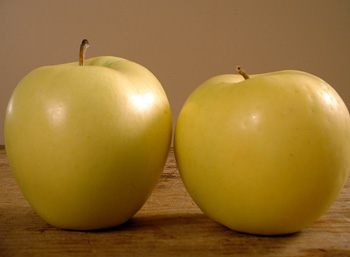 Golden Delicious Apples
Golden Delicious Apples© Denzil Green
Golden Delicious Apples are not related to Red Delicious at all, except that both happen to be apples.
A Golden Delicious Apple has a similar shape to Red Delicious, but a milder taste. The apples are large and very fragrant.
The skin is smooth and yellow, sometimes with russeting when the apple is fully ripe. The light yellow, juicy flesh is crisp but tender, with a sweet, mild taste.
The apple is good for eating out of hand, and cooking with, as it holds shape well when cooked. It is often added to apple cider.
Golden Delicious Apple trees do not grow well in the UK.
Cooking Tips
Golden Delicious apples are quite sweet. When cooking with them, hold back a bit on the sugar. In applesauce, the apples may not require any added sugar.
The flesh is slow to brown, making it useful for salads.
For home canning, they will semi-hold their shape when hot-packed (raw-packs result in poor quality product.)
Equivalents
3 medium golden delicious apples = 500 g / 1 lb
History Notes
Golden Delicious originated as a chance seedling discovered on Anderson Mullin’s farm in Odessa, Clay County, West Virginia in 1905, from a possible cross between Grimes Golden and Golden Reinette. Anderson Mullins watched the tree for the next 9 years, to see how it did. In 1914, he approached Stark Brothers Nursery.
The apple was named at first Mullin’s Yellow Seedling. Starks Brothers bought the rights in 1914 for $5,000 (possibly $5,000 to “rent” the tree, then with another possible $5,000 to buy it and the land surrounding it outright) and renamed it in 1916 to Golden Delicious. They put a fence around the tree so that people wouldn’t take cuttings, but some people did manage to, and the trees developed from those cuttings were called Yellow Delicious.
The original tree died sometime in the 1950s, being definitely dead by 1958.
Dr John Harvey Kellogg, of the breakfast cereal fame, loved Golden Delicious Apples.

